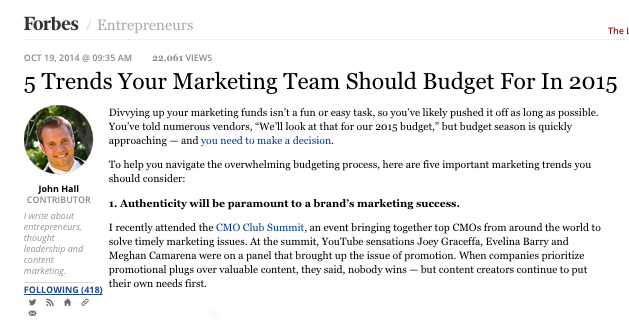 Do you know who Toni Basil is? What about Carl Douglas? My guess is no, but you do know the songs that made them one-hit wonders: “Mickey” and “Kung Fu Fighting,” respectively. You don’t remember the musicians because they didn’t build a following around a brand — they each built a cult following around one song, and after that song left the Top 40, they also left the spotlight.
Do you know who Toni Basil is? What about Carl Douglas? My guess is no, but you do know the songs that made them one-hit wonders: “Mickey” and “Kung Fu Fighting,” respectively. You don’t remember the musicians because they didn’t build a following around a brand — they each built a cult following around one song, and after that song left the Top 40, they also left the spotlight.
Those who think they and their companies can write a few great pieces of content and instantly reap the benefits of being industry leaders are the content marketing equivalents of Chumbawamba. By the way, remember “Tubthumping”?
Now, let’s take a look at a current Top 40 artist: Taylor Swift. What has she done differently from one-hit wonders like Toni Basil? She consistently delivers valuable content to her audience. One example is the wide variety of famous guests she’s tapped to appear on her 1989 World Tour — add-ons that offer value and make her concerts a major hit time and time again.
Content marketing works in a similar way. Getting ahead in thought leadership is all about how consistently you can create, publish, and distribute meaningful content:
Consistency Matters to Build an Audience.
Consistency in publishing educational and engaging content coming from experts on your team is important because it’s the only way you can begin to build a loyal audience.
John Hall, our CEO, is a great example of how consistency builds a following. When he started publishing his Forbes column, it was difficult to know which articles would go viral and which would silently disappear into the online publication graveyards.
Now that John has been publishing about three times per month for more than three years, we know we can expect consistency from his audience engagement. He has attracted a following of readers who look forward to his posts, and it shows in the numbers: In September 2012, John’s average article attracted about 2,000 views; this past September, that number was closer to 8,000.
Consistency Matters to Build Credibility.
Focusing on consistency in publishing does more than build an audience; it also lends credibility to your company.
Admit it: When you visit a company blog where nothing has been published in three months, you start to wonder what’s going on. My thoughts tend to range from “Is this company still in business?” to “If its team members can’t stick with an initiative themselves, how can I trust they’ll be reliable for me?”
Big gaps in content indicate to potential customers that you’re not on top of your game, and that’s never the signal you want to send.
Consistency Matters Because Content Marketing Compounds.
Our team at Influence & Co. has noticed that we still reap the benefits of articles we published years ago. Our marketing has seen more and more success because we have capitalized on the compounding effects of content marketing.
For example, people are still coming to our site from an article we published in October 2014 on five marketing trends for 2015.

Instead of just thinking, “Great! Now we can scale back publishing in 2015,” we’re writing content that engages these readers and keeps them coming back. We’ll probably write a post soon about which of those five trends had the most impact and what we expect to see in 2016. This strategy to re-engage people who are visiting from old posts is the holy grail of benefiting from consistent content.
To further explain how your content efforts can establish you as an industry leader, download our No. 1 resource on the blog, “The 8 Steps to Thought Leadership Through Content Marketing.”
Content Marketing Isn’t a Marathon — It’s a Fit Lifestyle.
I’ve heard a lot of people describe content marketing with the adage “It’s a marathon, not a sprint.” I’d disagree and posit that it’s not a marathon, either. A marathon implies a clear ending: You cross a finish line and fall to the ground with a mix of accomplishment and exhaustion.
But if you’re committed to continued growth and success for your organization, there is no finish line. Now, you don’t have to run a full sprint for years, but you should be consistently innovating your content marketing and engaging your audience in an authentic way. Most runners don’t immediately quit all fitness pursuits after they’ve completed a marathon. They take a break, eat some pasta, and start training for the next. You should do the same with your content marketing campaigns (though consider the pasta optional).
Ensure your brand doesn’t fall the way of Toni Basil, Carl Douglas, and other one-hit wonders by understanding that content marketing and thought leadership do not have definitive endings. These aren’t one-and-done strategies; they take consistency and the willingness to test, innovate, and continue forward.




 Do you know who Toni Basil is? What about Carl Douglas? My guess is no, but you do know the songs that made them one-hit wonders: “Mickey” and “Kung Fu Fighting,” respectively. You don’t remember the musicians because they didn’t build a following around a brand — they each built a cult following around one song, and after that song left the Top 40, they also left the spotlight.
Do you know who Toni Basil is? What about Carl Douglas? My guess is no, but you do know the songs that made them one-hit wonders: “Mickey” and “Kung Fu Fighting,” respectively. You don’t remember the musicians because they didn’t build a following around a brand — they each built a cult following around one song, and after that song left the Top 40, they also left the spotlight.




